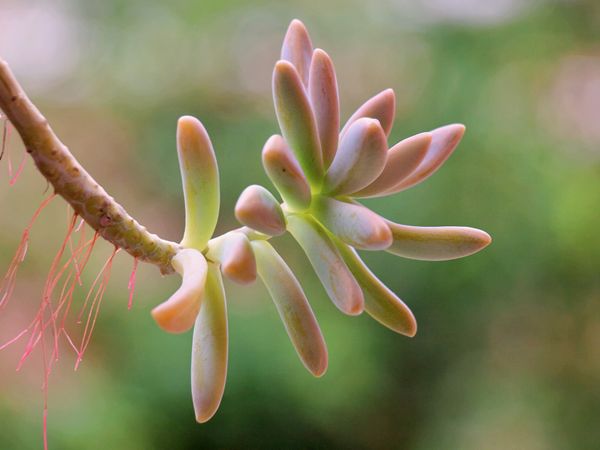Moonstones Care Guide
How to grow and care for Moonstones (Pachyphytum oviferum)
Welcome to the delightful world of Pachyphytum oviferum, commonly known as Moonstones. This charming succulent is beloved for its chubby, pebble-like leaves that resemble smooth stones, and its soft pastel colors of blue, pink, and green which can brighten any indoor space. Native to Mexico, Moonstones are relatively low-maintenance and make a lovely addition to your collection of houseplants.

Disclosure: This content includes affiliate links, which means we may earn a commission if you click on a link and make a purchase. As an Amazon Associate, we earn from qualifying purchases. This comes at no extra cost to you and helps offset the cost of running Leafwise. Please read our disclaimer for more info.
Table of Contents
Care
Light
Moonstones thrive in bright, indirect sunlight to maintain their signature pastel colors. A south-facing window works well, offering ample light without risking sunburn. They can tolerate some direct morning sunlight, but extended exposure to harsh midday rays may cause scorching. When transitioning to a brighter spot, acclimate the plant gradually to prevent damage.
Watering
During the growing season (spring and summer), water thoroughly using the "soak and dry" method—allowing the soil to dry out completely between waterings. Check leaf firmness for hydration clues: firm leaves indicate sufficient moisture, while soft or wrinkled ones suggest the plant needs water. In winter, when growth slows, reduce watering significantly to avoid root rot. Always ensure excess water drains freely.
Temperature & Humidity
Pachyphytum oviferum prefers temperatures between 60–80°F (15–27°C). It can withstand brief dips as low as 20°F (-6°C) but should be shielded from prolonged cold. Avoid placing it near air conditioners or drafty windows. These succulents flourish in dry indoor air and do not require additional humidity.
Soil
Use a gritty, well-draining soil mix formulated for cacti or succulents. A blend with coarse sand, perlite, or pumice encourages drainage and helps prevent root rot.
Fertilization
Fertilize sparingly. Apply a diluted cactus fertilizer once per growing season, preferably in spring or early summer when the plant is actively growing. Avoid fertilizing during fall and winter dormancy.
Maintenance
Pruning
Minimal pruning is needed. Remove dried or dead leaves at the base of the plant to improve air circulation and prevent pest problems.
Cleaning
Gently dust the leaves with a soft, dry brush to maintain their appearance. Avoid wiping with water, as this can remove the protective powdery coating (farina). The farina helps reduce moisture loss and shields the plant from sunburn—and it does not regenerate once removed.
Repotting
Repot every 2–3 years or when the plant outgrows its current container. Signs of being root-bound include roots circling the base or growing through drainage holes. Choose a slightly larger pot with good drainage and replace the soil to support healthy growth.
Propagation
Pachyphytum oviferum propagates well from leaf cuttings or by division.
Leaf Cuttings
- Gently twist off a healthy leaf from the main plant.
- Allow the leaf to dry for several days until a callus forms at the cut end.
- Place the callused leaf on top of well-draining soil.
- Mist occasionally until roots and new growth appear.
Propagation is most successful during the active growing season—spring or early summer is ideal.
Division
When repotting, gently separate offsets from the mother plant, ensuring each piece retains part of the root system. Replant in fresh succulent soil and care for as you would a mature plant.
Common Issues
Etiolation
- Cause: Insufficient light.
- Symptoms: Stretched, leggy growth; pale or faded coloration.
- Solution: Move to a brighter location with indirect sunlight or supplement with a grow light to restore compact form.
Pests
- Types: Mealybugs, aphids.
- Symptoms: Cotton-like masses, sticky residue, distorted growth.
- Solution: Remove pests with a cotton swab dipped in rubbing alcohol or treat with neem oil or insecticidal soap. Regular inspections help prevent infestations.
Diseases
- Cause: Overwatering, poor drainage.
- Symptoms: Mushy, blackened roots; leaf drop; foul odor from soil.
- Solution: Remove the plant from its pot, trim affected roots, and repot in dry, well-draining soil. Reduce watering frequency.
Yellowing Leaves
- Cause: Overwatering or low light.
- Symptoms: Soft, mushy leaves typically signal excess water; pale or stretched leaves often indicate light deficiency.
- Solution: Let soil dry out between waterings and move the plant to a location with bright, indirect sunlight.
Sunburn
- Cause: Intense direct sunlight.
- Symptoms: Brown, dry, or translucent patches; bleached or faded spots; crispy leaf surfaces.
- Solution: Relocate to a shadier spot and gradually reintroduce brighter conditions. Protect during peak sun hours, especially in summer.
With consistent care, Pachyphytum oviferum will flourish—offering lush, plump foliage in soft pastel shades. Handle with care to preserve the delicate farina coating, and enjoy this elegant addition to your succulent collection.
